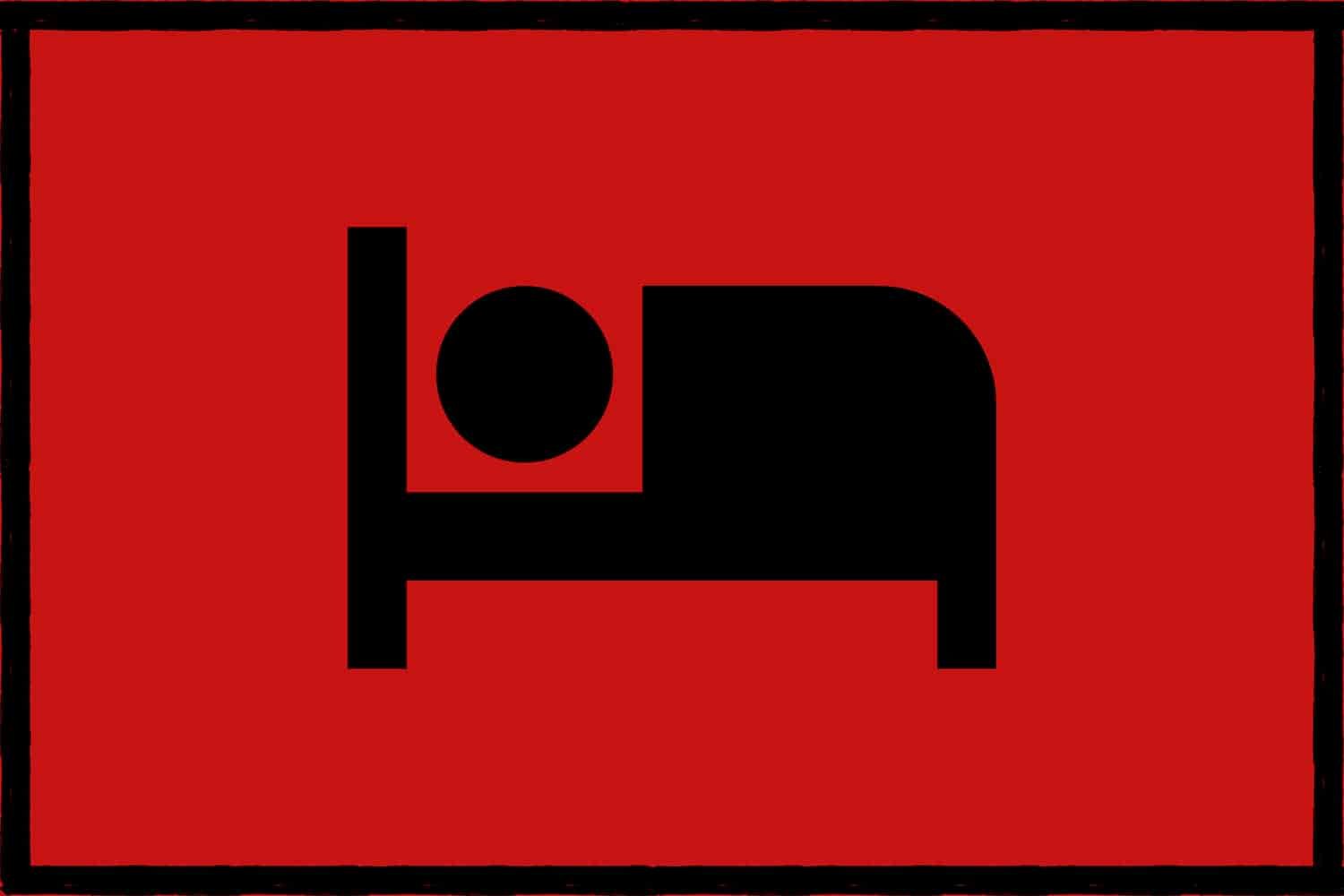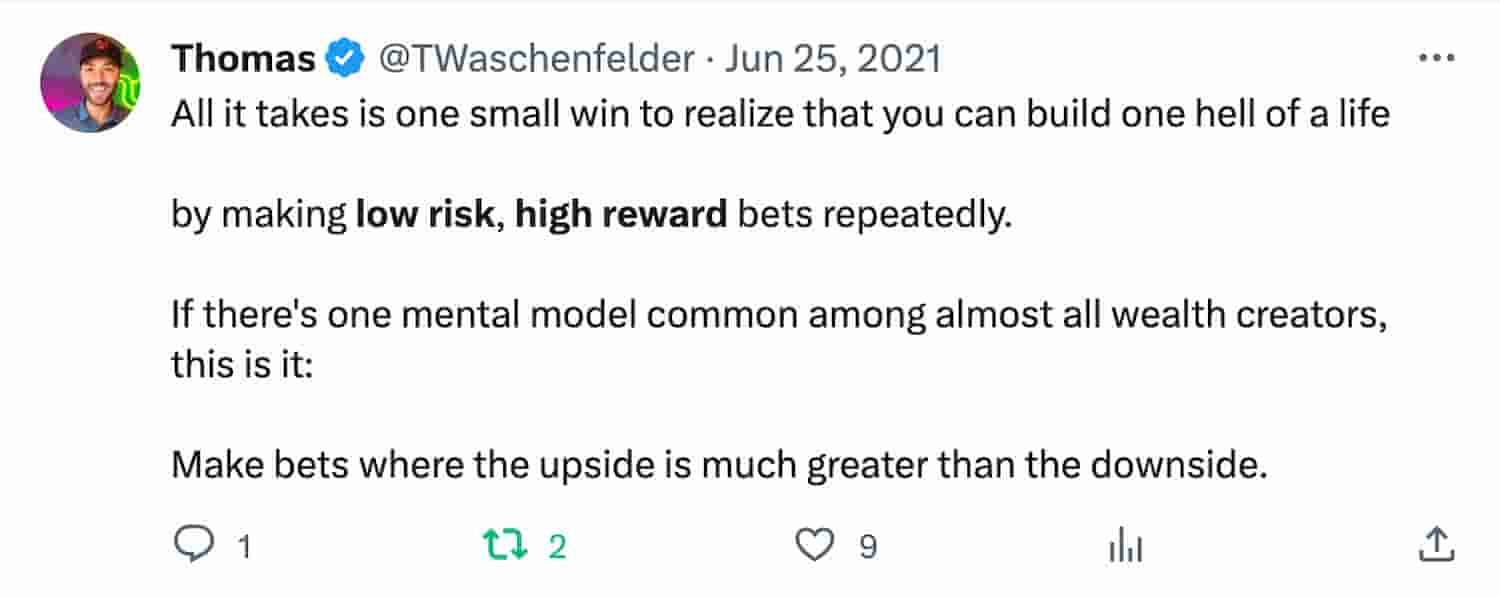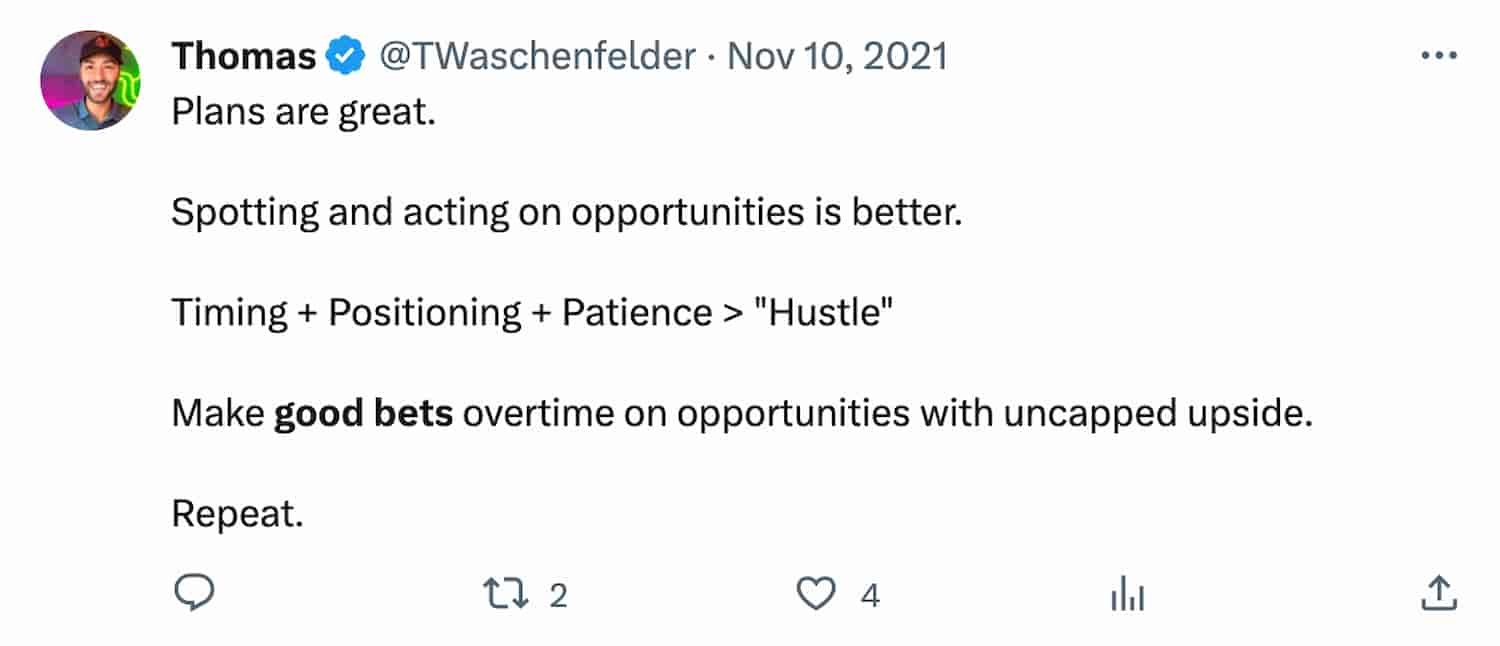Making Dhandho Bets: Heads You Win, Tails You Don’t Lose Much
I’ve been writing about the ideas of wealth creators for a year now, and I’ve noticed something profound. Each person I study has a different phrase for what amounts to the same idea: finding opportunities where the upside is much greater than the downside.
Naval Ravikant calls these Asymmetric Opportunities while Nassim Nicholas Taleb uses the phrase Fundamental Asymmetry. Charlie Munger names it value investing.
And investor Mohnish Pabrai simply calls it Dhandho.
What Is Dhandho?
Dhandho is an approach to business that seeks to minimize risk while maximizing reward. Mohnish Pabrai explores the idea of Dhandho in his book, The Dhandho Investor: The Low-Risk Value Method to High Returns.
Here’s Pabrai’s official definition:
Dhandho (pronounced dhun-doe) is a Gujarati word. Dhan comes from the Sanskrit root word Dhana meaning wealth. Dhan-dho, literally translated, means “endeavors that create wealth.” The street translation of Dhandho is simply “business.” What is business if not an endeavor to create wealth?
Pabrai further narrows the definition of Dhandho to making risk-free bets with massive upside one after another until you’re rich. He sums it up with the phrase, “Heads, I win; tails, I don’t lose much!”
Examples of Dhandho
Papa Patel’s Motel Business
Pabrai opens his book with a story about the Patels. The Patels are an Indian family from the state of Gujarat who now owns over half of the motels in America. How did they achieve that over 30 years?
With Dhandho. They knew how to make high-reward bets with virtually zero risk.
The Patels immigrated to Southern California in the 1970s with no education and no money. The first business they went into was the motel business.
In the early 1970s, the U.S. was in a deep recession, and gas prices were very high. Travel is a discretionary expense. When money is tight, you skip the vacation. As a result of the recession, hotel occupancy rates were very low, leading to bank foreclosures and fire sales. In other words, the Patels could get into the motel business for very, very cheap.
Papa Patel realized that with the bank highly motivated to sell a distressed asset, they were willing to finance 80 or 90 percent of the buy price. Plus, he could house his entire family in a few of the rooms, and they could help run the business. If they go broke, Papa Patel and his wife could always bag groceries, work overtime, and save up some money to try again. It was a low risk, high reward bet.
For a few thousand dollars down payment, Patel buys a motel. Without having to pay for staff (Papa Patel and his wife handle all the work), the Patels have no expenses. Combine that with their extremely frugal lifestyle, and the motel quickly turns profitable.
After a few years, Papa Patel now has enough cash to expand his business. He buys another motel and staffs it with other family members who have landed in the United States.
This process repeats itself until the Patel family owns over half of the motels in America while branching out into luxury hotels, condos, gas stations, convenience stores, and more. That’s Dhandho.
See, Papa Patel was fanatical about five things:
Keeping costs as low as possible.
Undercutting his competitors with lower prices.
Keeping occupancy high.
Maximizing free cash flow, and
Handing new motels to recently immigrated Patels who can repeat the process.
Patel was the low-cost producer in the motel business - this was his moat. He was able to keep costs lower than anyone else in the industry and used that edge to build an empire.
That’s Dhandho - a virtually risk-free bet with tremendous upside.
Richard Branson’s Virgin Atlantic
Pabrai explores the life of Richard Branson as another example of the Dhandho business model.
After Branson successfully built out his music and record distribution company, he was handed a proposal in 1984 for an airline specializing in first-class service between New York and London.
He was weary. He knew that a business plan involving a 747 jumbo jet must have been rejected everywhere else (by those with knowledge of the travel/flight logistics domain) for it to land on his desk. But he was curious. The plan stated that the current airlines were underserving this route.
That weekend, he called a handful of discount airlines but couldn’t get through. Either they were bad at their business (unlikely), or there was so much demand for that flight that the phones were always busy. Branson saw an opportunity. He changed the plan from a business-service only airline to one with a unique dual-class service and got to work.
First, he made a call to Boeing and got a quote for leasing a 747 jumbo jet. Then he ran some rough numbers and figured the venture would put about $2 million of his capital at risk. His record company was highly profitable. He had about $12 million in earnings for that year and a projected $20 million the next.
From a capital needs perspective, he would get paid for the tickets before he needed to pay out for fuel and staff wages. He didn’t need a ton of capital to get started. And he didn’t have to buy the airplane - he could lease it.
This was a low risk, high reward bet.
So, he started the airline. By the time his competitors realized there was a service gap to fill, he was well ahead of them with a great brand and a unique experience for a niche market. Branson went on to make similar bets with Virgin Mobile (acquired by Sprint), a Virgin Mortgage brand, and more.
Branson is worth about $4 billion today - built upon the back of low risk, high reward bets. That’s Dhandho.
Mohnish Pabrai’s Transtech
Pabrai tells his own Dhandho story in the founding of his first company - a software business called Transtech, Inc.
At 25-years-old, he had about $30K in retirement savings and $70K in credit card limits to start his company. After researching bankruptcy law in the U.S., he decided that if his business were to fail, he could just declare bankruptcy and start again. Pabrai felt he didn’t have much to lose because he didn’t have much, to begin with. The downside was low, while the upside was massive.
Pabrai worked on his business in the morning before his day job from 6:30 a.m. to 8:30 a.m. and in the evenings from 6:00 p.m. to midnight. With a paycheck coming in regularly and minimal expenses, he was free to focus on building his business for the longterm. Once he reached $200,000 / year in revenue and a regular client, he quit his day job.
Pabrai’s business relied on arbitraging between India’s deep talent in client-server computing, and the talent-shortage in the midwestern U.S. The business grew nicely. Pabrai sold it for several million dollars in 2000. The return was over 65 percent annualized over ten years.
Transtech was basically a risk-free bet. At 25 years-old, Pabrai had nothing to lose. He was only making a salary of $45,000/year when he quit, with no family to support, no girlfriend or wife. His downside was losing $30K in retirement savings when the upside was millions of dollars. That’s Dhandho.
How To Make Dhandho Bets
Pabrai gives us a framework for making Dhandho bets. You can see every one of these elements present in the story of Papa Patel.
Here’s Pabrai’s Dhandho investing model:
• Invest in existing businesses.
• Invest in simple businesses.
• Invest in distressed businesses in distressed industries.
• Invest in businesses with durable moats.
• Bet heavily when the odds are in your favor.
• Fixate on arbitrage.
• Buy businesses with a margin of safety.
• Invest in low-risk, high-uncertainty businesses.
• Invest in the copycats rather than the innovators.
Papa Patel's Dhandho Framework
Papa Patel didn’t try to innovate the hospitality sector. He was a copy cat, instead. Patel bought a relatively simple, existing business in a distressed industry during an economic recession. This almost guaranteed that he was buying with a margin of safety to the real value of the business. He was getting more than he was paying for.
He then went onto build a durable, low-cost producer moat by keeping his costs extremely low while arbitraging the cost of doing business between his motel and his competitors’ motels. His moat worked to undercut competing companies and maintain good margins.
Plus, Papa Patel made a bet when the odds were with him. The macroeconomic backdrop meant that the bank was motivated to help the Patel family make the motel work. And if the plan failed, they didn’t have much to lose. They could just make the bet again a few years later.
And while there was a wide range of outcomes for Papa Patel when he bought the business, the risk was still low. No one knew when the recession was going to end, and people would start spending money on travel again, but it would end at some point. And all Patel had to do was keep his costs low enough to survive until the recovery. That’s a low-risk, high uncertainty bet.
The Patels’ Dhandho framework is how they came to own more than half of the motels in the United States over the course of 30-years. That’s the power of Dhandho.
Dhandho Summary
Mohnish Pabrai’s Dhandho is the process of making risk-free bets with tremendous upside. It consists of 9 core-tenants that allow you to make “heads, I win; tails I don’t lose much” bets.
It’s how the Patels built their motel empire, and it’s how Richard Branson built out his Virgin brand. It’s how Mohnish Pabrai created his software company.
What can you build with the Dhandho framework?
If You Want More Content Like This, Subscribe To My Newsletter For Free:
—
Pabrai, Mohnish. The Dhandho Investor: The Low-Risk Value Method to High Returns. Wiley. Kindle Edition.







